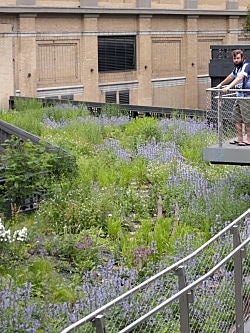
La página que intenta visitar sólo está disponible en inglés. ¡Disculpa!
The page you are about to visit is currently only available in English. Sorry!

 |
| Photo by Katherine Bagley, Audubon Magazine |
I finally gave in and went the new High Line park along Manhattan’s west side. Tucked among steel, glass and brick buildings, the old elevated train line is now home to lush gardens full with 210 species of wildflowers, meadow grasses, and trees. Hundreds of people ate lunches along the benches lining the path, despite the low-hanging rain clouds and thick humidity. Children strolled alongside their parents, stopping to examine each new flash of color in the dense vegetation. Birds darted from beneath branches of young trees. Views from the lofted corridor ranged from decrepit warehouses and Hudson River piers to trendy Meatpacking District restaurants and cavernous walkways through buildings. It is a sanctuary 30 feet in the air; a natural landscape nestled within an urban community and a green alternative for residents, workers, and visitors who want to avoid traffic congestion and vehicle exhaust on Tenth Avenue.
The High Line is a project 10 years in the making. The viaduct was originally constructed in the 1930s as part of a massive public-private infrastructure project to get dangerous freight trains off New York’s streets. For 50 years, the track fueled industry in southern Manhattan, hauling milk, meat, produce and raw manufactured goods out of the city. In 1980, due to highway construction and the consequential growth in interstate trucking, the High Line shut down, the last train pulling three carloads of frozen turkeys.
 |
| Photo by Katherine Bagley, Audubon Magazine |
For nearly two decades, the tracks were abandoned. Vegetation grew between the rusting rails and a lush meadow-like ecosystem sprouted in the middle of urban development. After pleas from several property owners to tear down the structure, local residents Joshua David and Robert Hammond founded Friends of the High Line and began advocating for the track’s preservation and development as a public open space.
After years of funding disputes, design competitions, and construction, the first part of the walkway opened June 9, running from Gansevoort Street to 20th Street. The final section will run from 20th Street to 30th Street and is expected to open by 2010.
Walking along the narrow pathway, there was a sense of calm among the visitors. Joggers gracefully danced between photographers focusing their cameras on stands of waist high grasses. Businessmen in suits waded through the crowds. Families meandered along the track. When the final stretch is completed next year, the High Line will be 1.5 miles of greenway for New Yorkers and a testament to what communities can achieve through innovation, design, and environmental thinking.